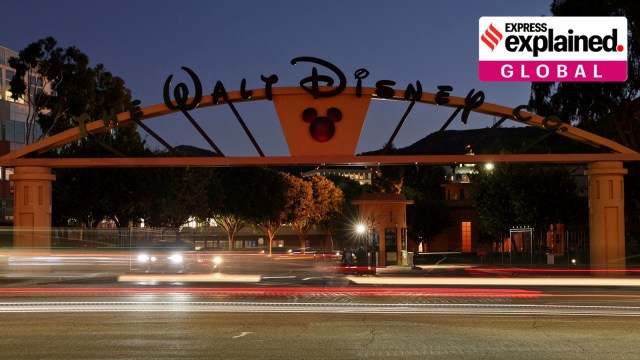Hollywood actors and writers’ strike called off: What we know about the deal so far
Reportedly valued at a billion dollars, what does the deal say? And why were actors and writers striking in the first place? What happens to movies and shows that had halted production? We explain.
 A view of the Walt Disney Studios, after the SAG-AFTRA TV/Theatrical Committee approved a tentative agreement with the Alliance of Motion Picture and Television Producers (AMPTP) to bring an end to the 118-day actors strike, in Burbank, California,. U.S. November 8, 2023. (REUTERS/Mario Anzuoni)
A view of the Walt Disney Studios, after the SAG-AFTRA TV/Theatrical Committee approved a tentative agreement with the Alliance of Motion Picture and Television Producers (AMPTP) to bring an end to the 118-day actors strike, in Burbank, California,. U.S. November 8, 2023. (REUTERS/Mario Anzuoni) After around four months of a strike over Hollywood writers and actors’ working conditions and contracts, unions representing them said a tentative deal had been reached with an alliance of film studios and streaming giants. Shooting of new films and TV shows, along with other production and promotional activities, had been put on hold in this period and is expected to resume in a few months.
Two unions – the Screen Actors Guild-American Federation of Television and Radio Artists (SAG-AFTRA) and the Writers Guild of America (WGA) – were leading two of the longest strikes ever. In a post on X on November 9, SAG-AFTRA said, “We’re thrilled to see SAG-AFTRA members win a contract that creates new protections for performers and gives them a greater share of the immense value they create.”
Why did the strike go on for so long, what does the deal say and how are Hollywood shows and movies likely to be impacted? We explain.
Why was Hollywood on strike?
The strike began in May 2023 with the WGA and actors’ union SAG-AFTRA joined in July this year. The two major unions went on strike at the same time after a gap of nearly 60 years.
The strikes were coordinated to address issues related to workers in the US entertainment industry, in view of a shifting business model – from traditional TV and movie theatres towards streaming platforms like Netflix, Disney, Amazon Prime, etc. Workers believed the rules governing them needed to be updated in favour of the workers.
For instance, in the era when TV was the main means of watching shows, screenwriters got paid for the repeat broadcasts of the shows they worked on (what was called ‘residual’ income). This was a steady source of income. However, streaming giants do not have similar provisions in place.
Another big concern was the rise of Artificial Intelligence (AI) and the potential of studios using tools like ChatGPT to write scripts and screenplays in order to cut their costs. Actors were also against the use of their likeness and face for future use by companies, to create videos or other content without their consent or compensation to them.
So what were the demands and were they met?
As reported in May, the union was demanding compensation amid a changing work culture and other improvements such as a hike in minimum pay, residuals for streaming and more contributions to the WGA health and pension plan.
On X, SAG-AFTRA posted, “In a contract valued at over one billion dollars, we have achieved a deal of extraordinary scope.” This is said to include “above-pattern” minimum compensation increases, “unprecedented” provisions for consent and compensation that will protect members from the threat of AI, and the establishment of a streaming participation bonus. There have also been improvements on the pension and health fronts. There will also be “compensation increases for background performers, and critical contract provisions protecting diverse communities.”
Full details of the deal will come out once it is reviewed by the SAG-AFTRA National Board, according to The Hollywood Reporter.
“A tentative agreement does not eradicate the potential for the strike to continue, as WGA leadership could still vote against lifting the union’s restraining order. And in terms of the contract, members could still reject the deal in an upcoming ratification vote,” it added. However, the unions were likely to attempt to convince their members to accept the deal.
But even as the deal has been celebrated, there are also concerns over the increased minimum pay and other pro-worker provisions. Platforms like Netflix and Disney are reportedly under pressure from investors over profitability and this could lead to a cutback in hiring and a reduced number of shows and films being produced. In turn, workers have criticised the bonuses awarded to high-ranking executives and questioned the claim of the need to cut costs.
What will happen to Hollywood shows and movies now?
First, the SAG-AFTRA National Board will have to review the deal. Then, its details will be released and the guild’s full membership will vote on it and it will then come into effect.
The Associated Press reported that the strike had put an immediate stop to big projects like Marvel’s ‘Deadpool 3’ starring Ryan Reynolds and Hugh Jackman, as well as Director Ridley Scott’s ‘Gladiator’ sequel and these are likely among the first films that will resume production.
Earlier in September, the Writers’ Guild reached a tentative deal, allowing work to resume on shows like ‘Abbott Elementary’ and ‘The White Lotus’. They could make their return more quickly.
- 01
- 02
- 03
- 04
- 05






































